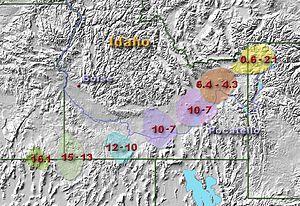geo.wikisort.org - Mountains
The Bruneau-Jarbidge caldera[1] (sometimes called a supervolcano)[citation needed] is located in present-day southwest Idaho. The volcano erupted during the Miocene, between ten and twelve million years ago, spreading a thick blanket of ash in the Bruneau-Jarbidge event and forming a caldera. Animals were suffocated and burned in pyroclastic flows within a hundred miles of the event, and died of slow suffocation and starvation much farther away, notably at Ashfall Fossil Beds, located 1,000 miles downwind in northeastern Nebraska, where up to two meters of ash were deposited. At the time, the caldera was above the Yellowstone hotspot.

By its uniquely characteristic chemical composition and the distinctive size and shape of its crystals and glass shards, the volcano stood out among dozens of prominent ashfall horizons[2] laid down in the Cretaceous, Paleogene, and Neogene periods of central North America. The event responsible for this fall of volcanic ash was identified at Bruneau-Jarbidge, 1,600 kilometers west in Idaho. Prevailing westerlies deposited distal ashfall over a vast area of the Great Plains.
The evolving composition of the erupted material indicates that while it is derived in large part from molten material from the middle or upper crust, it also incorporated a young basaltic component.[3]
Notes
- Bonnichsen, B. (1982). "The Bruneau-Jarbidge eruptive center, southwestern Idaho". In Bonnichsen, B.; Breckenridge, R. M. (eds.). Cenozoic Geology of Idaho. Bureau of Mines and Geol. Bulletin. Vol. 26. OCLC 12262425.
- The increasingly refined science of dating through layers of ash and other tephra thrown out by a volcanic event is called tephrochronology.
- Leeman, William P.; Annen, Catherine; and Dufek, Josef (2008). Snake River Plain – Yellowstone silicic volcanism: implications for magma genesis and magma fluxes, pp. 235–259 in Annen, Catherine and Zellmer, Georg F., Dynamics of Crustal Magma Transfer, Storage and Differentiation, Geological Society, London, Special Publications, 304. doi:10.1144/SP304.12.
References
- BBC: "Supervolcanoes" Program transcript, 3 February 2000
- W. I. Rose, C. M. Riley, and S. Dartevelle, "Sizes and Shapes of 10-Ma Distal Fall Pyroclasts in the Ogallala Group, Nebraska" (pdf file) Includes bibliography.
- Izett, G. A. (1981). "Volcanic ash beds: recorders of Upper Cenozoic silicic pyroclastic volcanism in the western United States". J. Geophys. Res. 86 (B11): 10200–10222. Bibcode:1981JGR....8610200I. doi:10.1029/JB086iB11p10200.
External links
- Cenozoic Geology of Idaho: "The Bruneau-Jarbidge Eruptive Center, Southwestern Idaho" by Bill Bonnichsen (pages 251-268) Idaho Bureau of Mines and Geology
Другой контент может иметь иную лицензию. Перед использованием материалов сайта WikiSort.org внимательно изучите правила лицензирования конкретных элементов наполнения сайта.
WikiSort.org - проект по пересортировке и дополнению контента Википедии